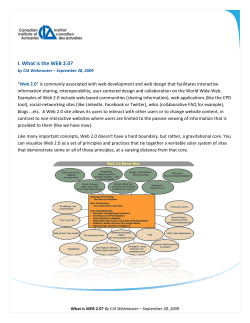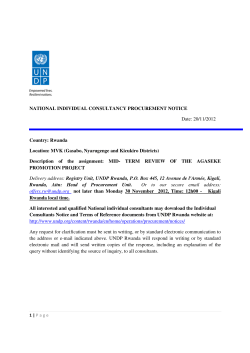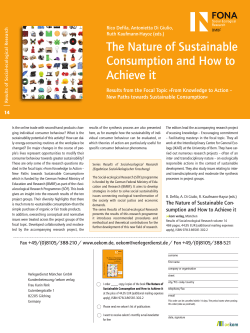
Changing Consumption Patterns Sustainable Management
Changing Consumption Patterns Sustainable Management - Sebastian Karwala - Windisch, 15.06.2005 1 Changing consumption and production patterns is the heart of sustainable development2. Consumption is an integral part of our life. It is present from the beginning to the end everywhere we go. We buy, eat, use and take advantages of different things. Of course consumption itself is not a menace for our world but its patterns and effects. In the course of time we become aware of the negative impact of our consumption patterns on the environment. This allow us to change and join the sustainable development approach. Consumer patterns change for both micro and macro reasons. At the micro level, changes are attributable to individual consumer's changing tastes. At the macro level, such changes occur because of structural shifts in the environment. This affects our behaviour, lifestyle, values and needs which implicate the change of our consumption patterns, which can vary between and within different countries and cultures (vide: Differences in consumption) based on specific sets of value-systems. As we know, nowadays the market belongs to the consumer. Owing to that the consumer dictates the conditions under the goods and services will be sold. Thus the “be or not to be of a company, brand or product” depends on the consumer. Although we make the end decision many factors has a direct influence on it. This right is often used by the producers for example in marketing strategies which has the aim to convince the customers to buy their products thus changing consumption attitudes. How? For example by: • increase of conviction that products of certain name have important features; • increase of importance key features of certain brand; • adding new feature to the structure of attitude; • decreasing of conviction about features of competitive brands. Fortunately, we are not alone in the consumption battle. In recent years many non government organization were lunched with the idea to help the consumer to identify the facts from a smart manipulation. Additionally there is a lot of rankings made by independent units which results are available through Internet, for instance: http://reviews-zdnet.com.com/ or www.test.de. Beside the consumption patterns we should also take into account the amount of 2 UNEP, Proposal for a work programme promoting sustainable consumption and production patterns, 22.07.2002, http://www.uneptie.org/pc/pc/pdfs/WP-Aug%2022.pdf 2 people. If we go back to the past, we will be witnessing the acceleration of human expansion. The first billion, passed around 1804, took perhaps 200 000 years to reach. The second billion took only 123 years and the third, reached in 1960, a mere 33 years. Since then we have been in overdrive, adding a billion every 13 or 14 years. In late 1999 the 6 billion3 mark late was passed. And today the world has to feed 6,5 billion4 (established Jan 2005) heads! What is more some sociologist assume that the population will increase in 5 years to almost 8 billion people which is a great problem form the present point of view regarding the consumption patterns. Below the population projection prepared by the United Nations. It is certain that the more people the greater the demand and consumption is. The additional fact is the upward tendency in GDP growth. In the OECD countries it will more than double till 2020, what might mean that also our consumption nature generate waste twice as big than in the '80. Below the adequate graph showing the connection. 3 Small World, World Population Awareness Week October 20–26, http://www.zpgmb.org/newsl023.html 4CIA, The World Factbook, http://www.cia.gov/cia/publications/factbook/rankorder/2119rank.html 3 Differences in consumption Worldwide the trend of changing consumption patterns remains the same - convenient and comfortable products are on the top. This refers although only to people with adequately high income. In Japan the market is characterized by consumption maturity. This means that almost all household own the necessities of life. In the year 2000 more than 80 percent of households had passenger cars, video decks, cameras and a CD player. The differences between poor and rich parts of the world are enormous. The North for instance - with only 25 per cent of the world's population - accounts for more than 80 per cent of the world's consumption of natural resources and generates more than 75 per cent of the world's municipal and industrial wastes. What is more the industrial countries have about 85 percent of the global income and have contributed to about 80 percent of the global CO 2 emissions since 19505 which follows by the statement that the North consumes 80 times as much energy as a person in Africa south of Sahara. The impact therefore of the North is considerable higher than of the poor parts of the world. This is here, where the unsustainable patterns are spread and menace the global environment. The answer for this was given in 1992 by the United Nations in Rio – look Upper initiative. 5The Norwegian Forum for Environment and Development Forum for utvikling og miljø (ForUM), www.iisd.ca/ consume/fjeld.html 4 Upper initiative “The major cause of the continued degradation of the global environment is the unsustainable pattern of consumption and production, particularly in industrialized countries6” Actions directed at the individual consumer must be integrated in a strategy. This was the main reason why amount others the problem of consumption patterns was put on the agenda of United Nations meeting. 178 Governments at the United Nations Conference on Environment and Development (UNCED) held in Rio de Janerio in June 1992 adopted a overall strategy called Agenda 21. The Chapter 4 of this Agenda was dedicated to improving the sustainability of development through more sustainable patterns of consumption and production. It include two programme areas. First focus on unsustainable patterns of production and consumption. The second refers to developing national policies and strategies to encourage changes in unsustainable consumption patterns. The aim of the strategies is to promote efficiency in production processes and reduce wasteful consumption in the process of economic growth, taking into account the development needs of developing countries. The last but not least is to develop a domestic policy framework that will encourage a shift to more sustainable patterns of production and consumption and to reinforce both values that encourage sustainable production and consumption patterns and policies that encourage the transfer of environmentally sound technologies to developing countries. The process of implementing Agenda 21, Chapter 4 is still in progress, supported by the business sector, NGO's, government agencies and international institutes, media and individual consumers. Below are the most significant examples work out by UN leading to achieve the goal of the Chapter 4 on the local, national, regional and international level: • application of the polluter-pays principle; • to improve the efficiency and productivity of energy, water and materials and reduce the levels of pollution and waste; • develop awareness-raising programmes, particularly among youth and other relevant segments in all countries, education, public and consumer information, advertising and 6UN Department of Economic and Social Affairs, Agenda 21 Chapter 4 Changing Consumption Patterns, http:// www.un.org/esa/sustdev/documents/agenda21/english/agenda21chapter4.htm 5 other media, taking into account regional, national and local cultural values; • develop and adopt consumer information tools; • financial support for capacity building, technology transfer and exchange of technology; • increase investment in cleaner production and eco-efficiency, through incentives, support schemes and policies directed at establishing appropriate regulatory, financial and legal frameworks; • establish and support cleaner production programmes and centres; • provide incentives for investment in cleaner production and eco-efficiency; • collect and disseminate information on cost-effective examples in cleaner production, ecoefficiency, environmental management and promote the exchange of best practices and know-how on environmentally sound technologies; • provide training programmes to small and medium-sized enterprises on the use of information and communication technologies; • integrate the issue of production and consumption patterns into sustainable development policies, including into poverty reduction strategies; • enhance corporate environmental and social responsibility and accountability through voluntary initiatives, environmental management systems, codes of conduct, certification and public reporting; • encourage relevant authorities at all levels to take sustainable development considerations into account in decision-making, including on national and local development planning, business development and public procurement; • promote internalisation of environmental costs, and the use of economic instruments. Of course, national governments have a huge field to show of (graphic on page 7) because many consumers lack practical perspectives for sustainable patterns of action and they just need clear leadership from the government (and industry and media as well). The other reason why consumers don't usually have a sustainable behaviour is: • Changing daily behaviour often costs a lot of effort. • Most consumers have not internalised sustainability into their thinking. • The public attention for environmental issues declines. • Primary aspects of the 'quality of life' for most consumers are health, freedom of choice, safety, luxury and comfort. Environment is secondary. 6 7 Importance of awareness and obstacles Why is changing consumption patterns so important? Why should we be involved in this process? We belong to this world and the concern of the future should be our greatest interest as UNECD identified unsustainable consumption patterns as a major threat to the global environment. What can we do in order to commit to sustainable development? A common reasonable and pragmatic consumption can lead to sustainable development, which goal is to achieve a reasonable and equitably distributed level of economic well-being that can be perpetuated continually for many human generations. To achieve this, consumption choices should though consider three areas: • Socially desirable development: fulfils peoples’ cultural, material and spiritual needs in equitable ways. • Economically viable development: pays for itself with costs not exceeding income. • Ecologically sustainable development: maintains the long-term viability of supporting ecosystems. Owing to various of education programs transmitted through the media, policies introduced by foreign countries leading to sustainable consumption (Gruener Punkt, return bottles, recycling, sorting of trash) people start to ask themselves why? - questions. Thus, they 1. Reduce consumption Manage waste 2. Stop using harmful products Responsibility 4. Enter a proactive behaviour 3. Start using responsible products become aware that the production processes of goods and services often have a strong direct or indirect impact in fields such as natural environment, public health, labour conditions, poverty levels, security standards, etc. 8 This builds a broad need of responsibility, which refers to four major approaches in the consumption patterns: 1. Reduce of consumption and waste management; 2. Discontinue using harmful for the environment products; 3. Purchase and use of responsible products; 4. Enter a proactive behaviour. The third and fourth point refers not only to products but also to the company which produces and distributes its goods or services. This includes social and environmental responsible production, ethical investment and fair trade. Today, the sensitivity of consumer is very noticeable, primo because of the role of media and secundo of the numerous alternatives. (great competition). That is why Public Relations dominated the understanding of advertisements. The reason? Of course, the wish to show the public that their firm is responsible, most willingly “for the whole world”. Below a cite7 from the web page of a tobbaco leading concern: “We take our social responsibility seriously. And youth smoking is a social problem. Shortterm measures and one-off anti-smoking campaigns are unlikely to solve it. What it calls for is a broad-based and sustained effort, and we are committed to working with all of society to bring about a long-term solution”. Philip Morris is one of the examples how to balance the irresponsible product (cigarettes) with responsible campaign and behaviour. Without this attitude the concern had to go down because of the common critic. It is important to be aware that consumers perceive the company not only as a source of production but before they make the decision if to buy the product or not they take into account other factors which are not directly linked to the quality or functionality of the product. In the year 2000 there was a MORI survey made for consumption responsibility in Europe. The objective was to assess the attitudes of European citizens on this subject. In the survey took part 12.000 consumers across 12 countries. 70% of them admitted that a company’s commitment to social responsibility is important when buying a product or service; 40% would be willing to pay more for products that are environmentally and socially 7 Phillip Morris International, http://www.philipmorrisinternational.com/pages/eng/ysp/YSP.asp 9 responsible and 58% of the believe businesses do not pay enough attention to their social responsibilities at present. Changing consumption patterns in relationship to natural and organic products is nowadays an important clue of the upward tendency of customers looking for sustainable products. Natural food sales totaled $8.3 billion in 1998, up 8 % from 1997. Organic sales were $ 3.5 billion, up 14 %, while conventional-food sales grew only about 2 %. There are predictions that natural food sales will reach $60 billion by 2008 and account for 10 % of the total retail food market1. A lot of consumers despite of the awareness do not consume sustainable goods and services. The reasons according to a Pulse Study, in Industry as a partner for sustainable development – Advertising, wrote by MacCain Erickson are: • Sustainable products are usually more expensive than the non-sustainable alternatives due to the small market mass. • It requires more efforts to purchase sustainable products than to buy their unsustainable equivalents. Consumers often lack the signposts to help them find more sustainable products. • The image of sustainable goods and services is unfavourable compared to unsustainable products and services. For many consumers, sustainability or ecology refers to problems, limitations, scantiness and thrift, conflicting with their perception of quality of life. • Information about the sustainability of products does not meet the specific needs of the trend-followers. 10 Conclusion Changing consumption patterns is a natural process of choice. Owing to the common effort to introduce a sustainable consumption promoted by NGO's or media it is possible to achieve the results written in the Agenda 21. There are still obstacles like price, human objections but as the last decade show, the tendency of using environmental friendly products, services is growing. Of course, unsustainable patterns of consumption are the domain of the industrialized countries of the North, who consume a vastly disproportionate share of the world's natural wealth and to produce an equally disproportionate share of global pollution. However, the dynamics are changing, and with the countries of the South eager to industrialize and develop themselves, there is considerable concern that new models be found for development that do not imitate the consumption patterns characteristic of the North in the past four or five decades. It means it is time to acting fast to imply the sustainable consumption patterns to prevent a deepen of environmental degradation. 11 Bibliography: 1. UN Department of Economic and Social Affairs. Division for Sustainable Development Agenda 21 Chapter 4 Changing Consumption Patterns http://www.un.org/esa/sustdev/documents/agenda21/english/agenda21chapter4.htm; 2. Nick Robins and Sarah Roberts, Rethink Paper Consumption, http://www.iied.org/smg/pubs/rethink1.html#section2; 3. Peter D., Sustainable Consumption, http://www.ens.gu.edu.au/aes1161/Topic8R1.htm; 4. Byung-Hwan Cho, FACILITATING SUSTAINABLE CONSUMPTION AND PRODUCTION, http://odin.dep.no/odinarkiv/norsk/dep/md/1996/publ/022005-990618/dok-bn.html; 5. István György Tóth, Consumption patterns and future expectations in three transition countries, http://www.ceorg-europe.org/consump/ 6. Solgaard Anne, Life-Cycle thinking - a thrust for sustainable consumption, http://unit.aist.go.jp/lca-center/lcaactivity/symposium/02_sympo/030319_document/S1-2%20Solgaard.pdf 7. Barret John, Sustainable Development Studies Programme, Presentation on Material Flow Analysis and Ecological Footprints; 8. McGill University, Evolving Concepts of Sustainable Development, Winter 2003; 9. Commenne Vincent, Responsible consumption: a general presentation, EBBF Conference – 2004 10.Human Development Report 1998 Overview, United Nations Development Programme (UNDP), http://hdr.undp.org/reports/global/1998/en/pdf/hdr_1998_overview.pdf 11.Human Development Report 2004, United Nations Development Programme (UNDP), http://hdr.undp.org/reports/global/2004/pdf/hdr04_complete.pdf 12.CIA, The World Factbook, http://www.cia.gov/cia/publications/factbook/rankorder/2119rank.html 13.Changing consumption behaviour, http://www.acrr.org/resourcities/dematerialisation/behaviour.htm 12
© Copyright 2025





















